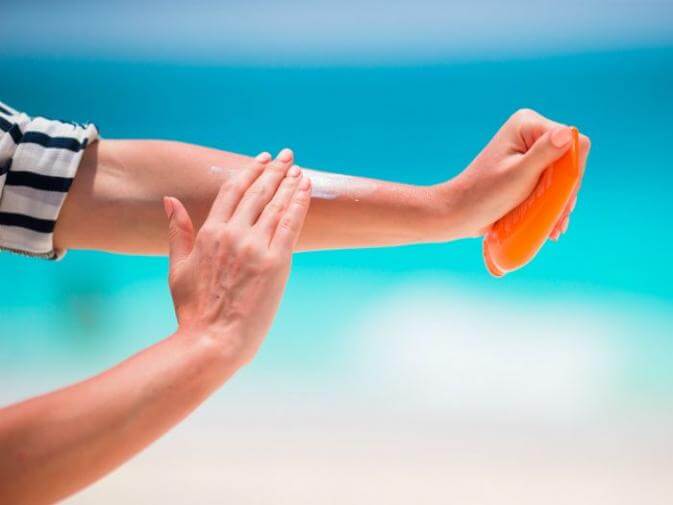Why Is Hawai’i Banning Sunscreen?
Recent research shows that oxybenzone and octinoxate are detrimental to coral growth and increase the rate of coral bleaching.
Sabrina Stierwalt, PhD
Listen
Why Is Hawai’i Banning Sunscreen?

Oxybenzone and octinoxate. These chemical names may sound unfamiliar, but it is very likely that you have slathered them over your body more than once. Oxybenzone and octinoxate are the chemicals found in sunscreens that are under consideration for a ban in the state of Hawai’i. While Hawai’i would be the first state to ban the sale and distribution of the potentially problematic sunscreens, a few resorts, ocean tours, and other tourist areas in Mexico, like several on the island of Cozumel, already ban their use.
These ingredients offer our skin protection from burns and potentially cancer by absorbing harmful ultraviolet radiation before it reaches our skin. However, recent research shows that oxybenzone and octinoxate are detrimental to coral growth and increase the rate of coral bleaching. They are also shown to damage coral DNA, to impair coral reproduction, and to make it harder for coral to heal after breakage.
Why are some sunscreens harmful to coral reefs?
The main study that has inspired the ban against the ingredients oxybenzone and octinoxate in particular suggests that after these chemicals are washed off our bodies and into the ocean waters, they produce hydrogen peroxide when combined with sunlight. Hydrogen peroxide, in turn, acts as a strong oxidizing agent which inhibits the growth of tiny microorganisms called phytoplankton. Although tiny, phytoplankton serve as the base of the food chain affecting everything that relies on phytoplankton for food, and then everything that relies on the marine life that eats phytoplankton, and so on and so on, all the way up through algae, sea urchins, fish, and marine mammals.
Another study suggests that the harmful ingredients in sunscreens promote viral infections among coral potentially leaving them more prone to bleaching.
Why should we try to save coral reefs?
The vibrant colors we see in coral are an indication of the coral’s health. Coral live in a symbiotic, or mutually beneficial, relationship with little algae known as zooanthellae. The zooanthellae make the coral their home, and in exchange for that home, they provide the coral with oxygen, food, and their bright colors. But if conditions aren’t right—for example if ocean water temperatures are too high or too acidic—the algae leave the coral, stripping it of its bright color, but also its food and oxygen.
Coral bleaching, or the whitening of coral, thus indicates the death of the coral and its surrounding ecosystem. Bleaching is linked to decreasing oxygen levels ocean-wide which means trouble for fish, whales, and turtles. And trouble in the marine ecosystem doesn’t just stay in the ocean: 70% of the oxygen in the atmosphere—yes that’s the air we breathe!—is produced by marine plants like phytoplankton and kelp. Billions of people also directly rely on coral reefs for food and revenue from sources like tourism.
Coral covered as much as 50% of Caribbean reefs in the 1970s but are found over only 8% of the Caribbean reefs today. In Australia, the country is currently spending $500 million to try to save the Great Barrier Reef which is home to over 600 types of coral and considered the largest living thing on Earth. An estimated half of the coral died between 2016 and 2017.
Should you go without sunscreen?
So how does my putting on a little sunscreen lead to the destruction of an entire ecosystem? It may not seem like much, for a layer of lotion to rinse off your skin and into the ocean, but an estimated 4 kilograms of mineral nanoparticles are washed into the ocean each day at a single popular tourist spot when added up over all of the visitors.
I remember resisting when my mother insisted on giving me a white nose back in the 90s for extra sun protection. Who knew she was helping protect coral reefs while also embarrassing her children?
So should we skip the sunscreen? According to a report by National Public Radio, oxybenzone and octinoxate are found in more than 3500 of the most popular sunscreen products. That’s between 40 and 70% of the products available for purchase for us beachgoers. But the Hawai’i legistlation, if signed by the governor, does not take effect January 1, 2021, leaving plenty of time for companies to come up with greener alternatives.
Plants, for example, produce their own natural form of sunscreen without the need for these harmful synthetic chemicals. Shinorine is one such natural sunscreen that is produced by cyanobacteria to protect themselves from solar radiation. Shinorine is also already a key active ingredient found in cosmetics that promise SPF protection.
Before more of these biodegradable sunscreens are available, there are some mineral sunscreens, like those with zinc oxide or titanium dioxide, that are still safe to use. These sunscreens act more like a physical barrier rather than a chemical one, deflecting UV rays away from your skin instead of absorbing them. These sunscreens tend to be less popular because they leave a white layer on the skin. I remember resisting when my mother insisted on giving me a white nose back in the 90s for extra sun protection. Who knew she was helping protect coral reefs while also embarrassing her children?
Of course, sunscreens are not the only thing threatening coral reefs. Global warming (which warms and acidifies the oceans), overfishing, and pollution like runoff from storm water, agricultural runoff, and untreated sewage also pose huge problems for coral reefs and thus the entire marine ecosystem. But sunscreen usage is something that you and I as individuals can easily manage with our daily choices.
Until next time, this is Sabrina Stierwalt with Ask Science’s Quick and Dirty Tips for helping you make sense of science. You can become a fan of Ask Science on Facebook or follow me on Twitter, where I’m @QDTeinstein. If you have a question that you’d like to see on a future episode, send me an email at everydayeinstein@quickanddirtytips.comcreate new email.
Image courtesy of shutterstock.

